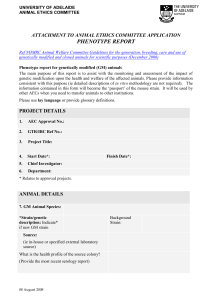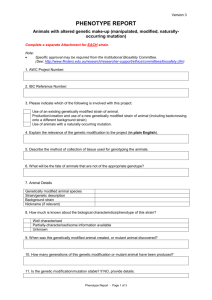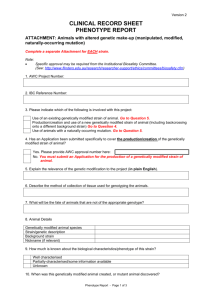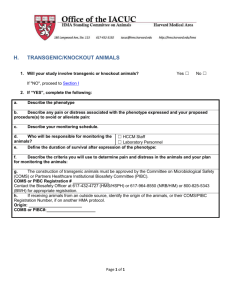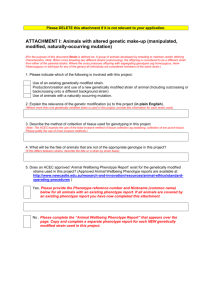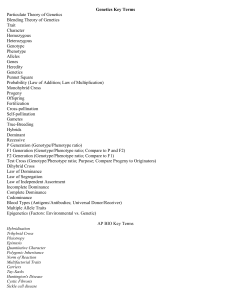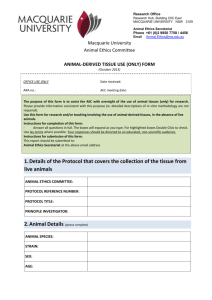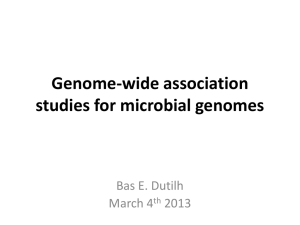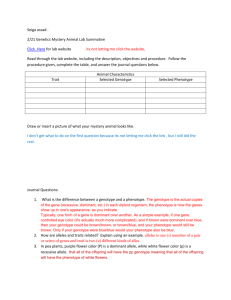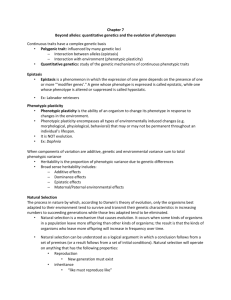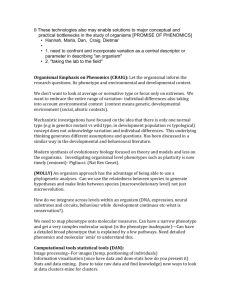Animal Ethics Committee - Research Office
advertisement
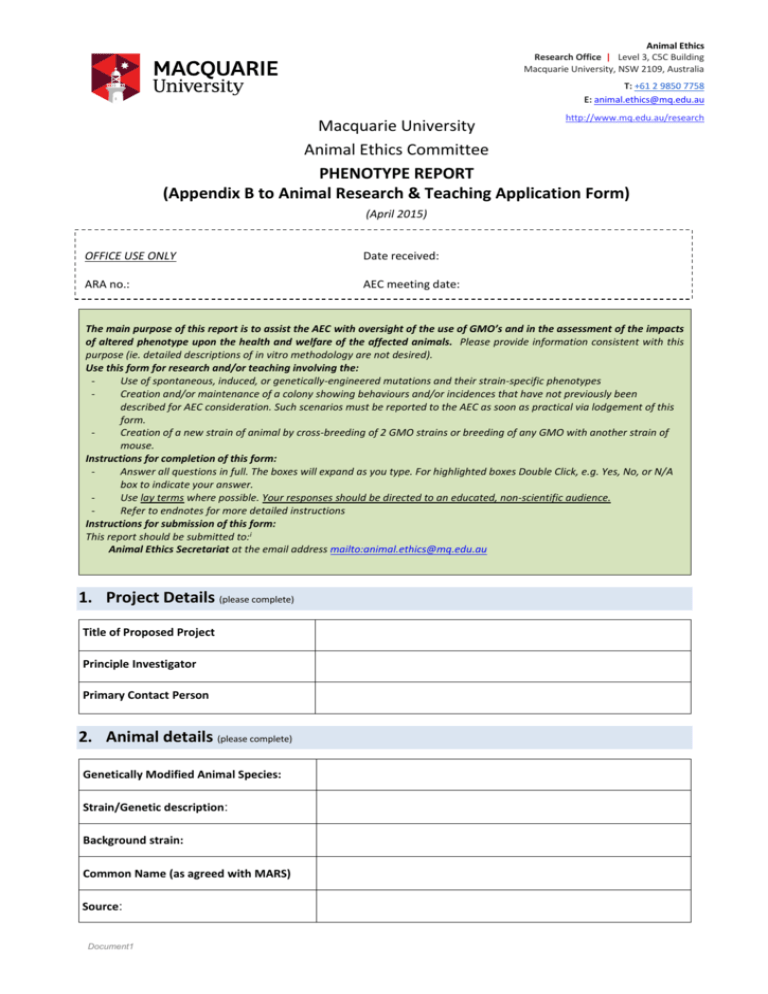
Animal Ethics Research Office | Level 3, C5C Building Macquarie University, NSW 2109, Australia T: +61 2 9850 7758 E: animal.ethics@mq.edu.au http://www.mq.edu.au/research Macquarie University Animal Ethics Committee PHENOTYPE REPORT (Appendix B to Animal Research & Teaching Application Form) (April 2015) OFFICE USE ONLY Date received: ARA no.: AEC meeting date: The main purpose of this report is to assist the AEC with oversight of the use of GMO’s and in the assessment of the impacts of altered phenotype upon the health and welfare of the affected animals. Please provide information consistent with this purpose (ie. detailed descriptions of in vitro methodology are not desired). Use this form for research and/or teaching involving the: Use of spontaneous, induced, or genetically-engineered mutations and their strain-specific phenotypes Creation and/or maintenance of a colony showing behaviours and/or incidences that have not previously been described for AEC consideration. Such scenarios must be reported to the AEC as soon as practical via lodgement of this form. Creation of a new strain of animal by cross-breeding of 2 GMO strains or breeding of any GMO with another strain of mouse. Instructions for completion of this form: Answer all questions in full. The boxes will expand as you type. For highlighted boxes Double Click, e.g. Yes, No, or N/A box to indicate your answer. Use lay terms where possible. Your responses should be directed to an educated, non-scientific audience. Refer to endnotes for more detailed instructions Instructions for submission of this form: This report should be submitted to:i Animal Ethics Secretariat at the email address mailto:animal.ethics@mq.edu.au 1. Project Details (please complete) Title of Proposed Project Principle Investigator Primary Contact Person 2. Animal details (please complete) Genetically Modified Animal Species: Strain/Genetic description: Background strain: Common Name (as agreed with MARS) Source: Document1 3. Genetic alteration How much is known about the biological characteristics/phenotype of this strain? Indicate by selecting one of the following: Well characterised and normal phenotype (append supplier phenotype report and got to section 6, and mark N/A for questions 4 and 5)ii Well characterised with abnormal phenotype (Complete all sections) Partially-characterised/some information available (Complete all sections) Unknown (indicate Unknown in question 4 and any special monitoring in question 5) iii Briefly describe which gene has been added /deleted/ altered (if known) Affected organs/tissuesiv Is animal health, welfare, breeding or lifespan likely to be affected? Yes; fill out all parts of this form No; no phenotypic effectsv (N/A for sections 4 and 5) 4. Phenotype (Line or strain information) N/A (no phenotypic effects), OR Describe the phenotype here or append the phenotype report from the supplier to briefly detail all observations and abnormalities which characterise the genetically modified animal strain or line 5. Special Husbandry and minimisation of pain or distress N/A (no special husbandry), OR Please provide details of special monitoring or husbandry requirements Attach any special monitoring documents 6. Biosafety Declaration Do you have Biosafety approval for this strain and the methods as detailed in the corresponding AEC protocol(s)? Yes No Please visit the Biosafety website for more information http://www.research.mq.edu.au/for/researchers/how_to_obtain_ethics_approval/biosafety_research_ethics/for ms Check the relevant box below Biosafety Approval obtained Please provide the approved Biosafety Reference Number(s) that cover the methods and GMO strains to be employed under this protocol Biosafety Application submitted, yet to be notified of outcome. Document1 7. Certification of the Chief Investigator I confirm that: The use of animals in this project will comply with the Australian Code for the Care and Use of Animals for Scientific Purposes, NH&MRC 8th Edition 2013 and the NSW Animal Research Act 1985 and Regulation 2010. I have prepared this phenotypic report to highlight the special welfare and ethical issues related to these animals, having read the Guidelines for the generation, breeding, care and use of genetically modified and cloned animals for scientific purposes. Signed: date 8. Certification of the Primary Contact Person I confirm that: I am familiar with the animals and the projects for which they will be used I am willing and able to be the primary contact for communications regarding the animals Signed: date 9. Certification of the Animal Facility Managervi I confirm that: The care of animals in this project will conform to the Australian Code for the Care and Use of Animals for Scientific Purposes, NH&MRC 8th Edition 2013 and the NSW Animal Research Act 1985 and Regulation 2010 and the Guidelines for the generation, breeding, care and use of genetically modified and cloned animals for scientific purposes. There is adequate space and staff in the facility for compliance Signed: date Endnotes i Submit with an Application for Research & Teaching Form, or if animals being imported to the CAF prior to a research application being submitted, please send with a covering letter of intention to use these animals at a later date and we will add this phenotype report to our portfolio for future referral. ii A Link to a web site is adequate iii For example, newly bred phenotype iv For example, phenotype expressed in liver tissue only, or produces low malarial peak parasitaemia but no other phenotypic differences to wild type are currently detected v Animals from a line must have been monitored for their whole lifetime for at least 4 generations if possible, with no phenotypic effects detected, to mark “No”, otherwise complete the sections 4 and 5 with what monitoring data has been done thus far. vi The researcher must consult with the CAF manager to ensure that there is staff and space to house the animals and that any monitoring or management particular to that line or strain is agreed upon. Document1
